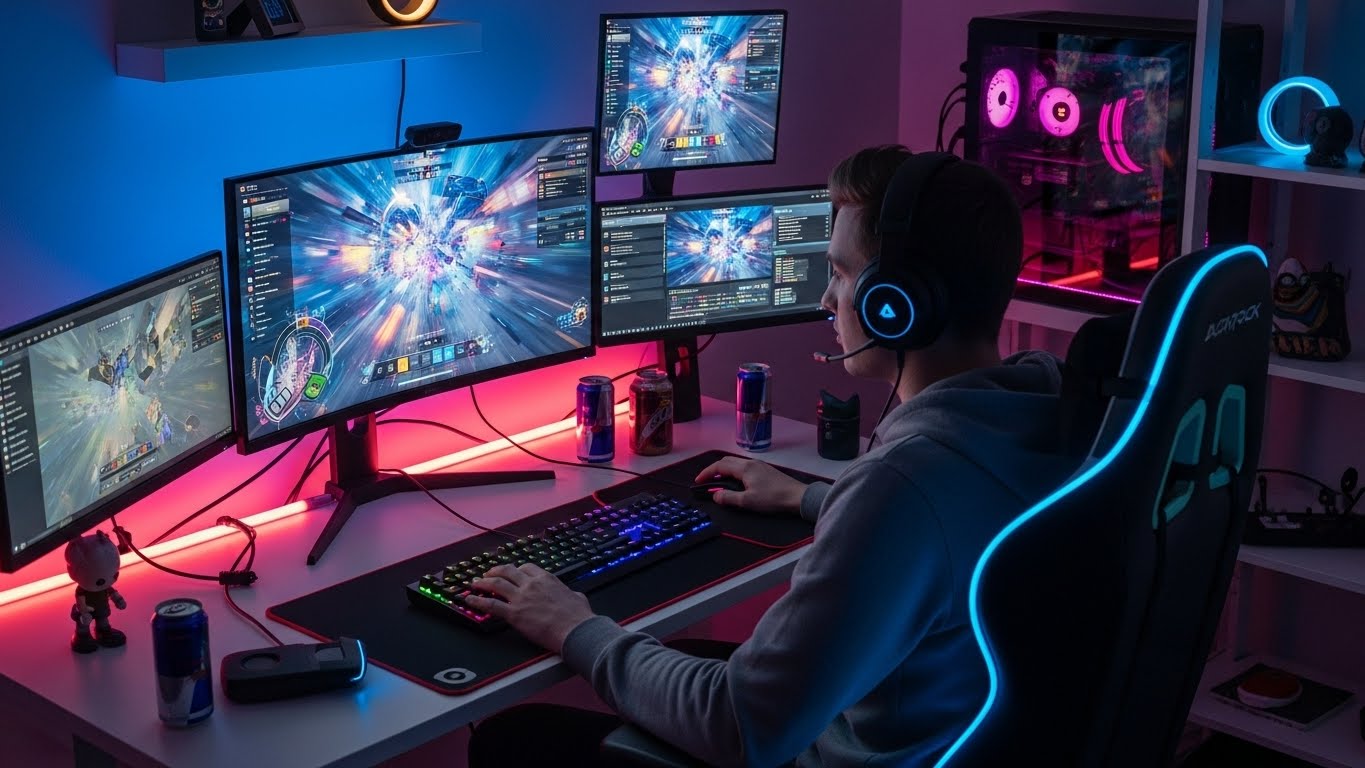Introduction
Gaming has become one of the most influential forms of entertainment and culture in modern society. What began as a simple pastime with blocky graphics and limited controls has evolved into a multi-billion-dollar global industry that shapes technology, art, storytelling, and even social interactions. Today, gaming isn’t just about fun—it’s about creativity, competition, community, and the boundless potential of digital imagination.
In this post, we will explore how gaming has evolved over the decades, how it impacts players psychologically and socially, the technological innovations driving it forward, and what the future of gaming might look like.
The Humble Beginnings of Video Games
Before gaming became a global phenomenon, it started as an experimental curiosity. The earliest video games appeared in research labs in the 1950s and 1960s. Simple programs like Tennis for Two and Spacewar! were created by scientists who wanted to test new computer systems. These games lacked commercial ambition; they were mere demonstrations of what early computers could do.
The real breakthrough came in the early 1970s with Pong, developed by Atari. Pong’s simple yet addictive gameplay captured public imagination and gave birth to the arcade culture. Suddenly, people were crowding around machines, competing for high scores, and sharing a new social experience centered around interactive entertainment.
The Rise of Home Consoles
By the late 1970s and early 1980s, the gaming industry shifted from arcades to living rooms. The introduction of home consoles like the Atari 2600 and later the Nintendo Entertainment System (NES) transformed gaming forever. These consoles allowed players to experience their favorite arcade titles without leaving home.
The NES era, in particular, became a golden age. Iconic franchises such as Super Mario Bros., The Legend of Zelda, and Metroid defined what it meant to design engaging, imaginative games. Each title introduced players to expansive worlds, clever level design, and memorable characters. Gaming became not just a form of play—it became a narrative and creative art form.
The 1990s: A Decade of Revolution
The 1990s were a revolutionary decade for gaming, both technologically and culturally. The transition from 2D to 3D graphics changed everything. Games like Super Mario 64, Tomb Raider, and Final Fantasy VII redefined what was possible. For the first time, players could move freely through three-dimensional worlds, immersing themselves in cinematic storytelling and dynamic gameplay.
The decade also saw the rise of fierce competition among console makers. Sega, Nintendo, and Sony battled for dominance, each introducing innovations that pushed the industry forward. The PlayStation’s use of CDs allowed for larger and more complex games, while Nintendo continued refining gameplay mechanics and controller design.
PC gaming also flourished during this period. Titles like Doom, StarCraft, and Half-Life expanded gaming beyond the console market, introducing multiplayer experiences and modding communities that would shape the future of gaming culture.
The Internet Changes Everything
The arrival of the internet brought a monumental shift in how games were played and shared. In the early 2000s, online multiplayer gaming emerged as a new social frontier. Titles like Counter-Strike, World of Warcraft, and Halo 2 introduced millions of players to the concept of global competition and cooperation.
Gaming was no longer a solitary activity. It became a connected experience where players could interact, form friendships, or compete in massive online arenas. The rise of broadband internet made real-time multiplayer possible, paving the way for esports and streaming culture later on.
This era also marked the growth of digital distribution. Platforms like Steam revolutionized how games were bought and updated. Instead of physical discs, players could download their games directly—a model that has since become the norm.
The Birth of Esports
Esports—organized, competitive video gaming—emerged as one of the most fascinating developments in modern gaming culture. What began as small local tournaments grew into massive global events with millions of viewers and professional players.
Games like League of Legends, Dota 2, and Counter-Strike: Global Offensive became the backbone of this phenomenon. Prize pools reached millions of dollars, teams gained sponsorships, and professional gamers became celebrities.
Esports also helped legitimize gaming as a professional pursuit. Universities began offering esports scholarships, brands invested heavily in tournaments, and millions tuned in to watch live events. What was once considered a niche hobby had transformed into a spectator sport on par with traditional athletics.
The Social Dimension of Gaming
Modern gaming is deeply social. Whether through multiplayer lobbies, online chat, or cooperative gameplay, gaming today is about connection as much as competition.
Platforms like Discord, Twitch, and in-game communities have allowed gamers to create spaces for sharing experiences, strategies, and friendships. For many, gaming serves as a social outlet—a place to relax, belong, and communicate in creative ways.
This social aspect also gave rise to content creators and streamers. People no longer just play games—they watch others play, discuss strategies, and even make careers out of it. The relationship between players, developers, and creators has never been more interactive.
Gaming as Art
For years, debates raged over whether video games could be considered art. Today, few would deny it. The medium has evolved into a powerful form of artistic expression, combining visuals, music, narrative, and interactivity in ways no other art form can.
Games like Journey, The Last of Us, Red Dead Redemption 2, and Celeste demonstrate emotional depth, storytelling sophistication, and aesthetic beauty that rival film and literature. These titles explore human experiences, moral choices, and philosophical questions through gameplay.
Game design itself is an art form—a meticulous balance of mechanics, story, and engagement. Developers act as artists, writers, architects, and psychologists all at once, crafting experiences that evoke emotion and challenge perception.
The Psychology of Gaming
Gaming is more than entertainment—it’s also a psychological phenomenon. Studies show that games can enhance cognitive skills, improve problem-solving, and even relieve stress. The interactive nature of gaming stimulates creativity and engagement in ways that passive media cannot.
However, like any form of entertainment, balance is essential. The immersive nature of games can lead to overuse or addiction for some players. The key lies in moderation and awareness.
Interestingly, gaming has also become a therapeutic tool. “Serious games” are used for mental health, education, and rehabilitation. Titles designed for anxiety management, cognitive training, or physical therapy have shown significant benefits. This growing field of game-based therapy demonstrates gaming’s positive potential when harnessed thoughtfully.
The Power of Storytelling in Games
One of the most profound transformations in gaming is its approach to storytelling. Early games relied on simple premises: save the princess, defeat the villain, score the highest points. Modern games, however, deliver complex narratives filled with emotional depth, moral ambiguity, and character development.
Games like The Witcher 3, Mass Effect, and God of War immerse players in intricate stories where choices matter. These interactive narratives create a sense of agency—players don’t just watch the story unfold; they shape it.
This interactivity makes storytelling in games uniquely powerful. Players feel responsible for their actions and outcomes, creating deeper emotional investment. It’s storytelling not just seen or read—but lived.
The Role of Technology in Gaming Evolution
The evolution of gaming has always been tied to technological innovation. Each generation of consoles and computers has introduced new capabilities that expand what’s possible.
The rise of powerful GPUs and processors has made ultra-realistic graphics and complex physics possible. Virtual reality (VR) and augmented reality (AR) are pushing the boundaries of immersion. Players can now step directly into game worlds, experiencing environments in a fully interactive 360-degree space.
Artificial intelligence also plays a growing role. NPC behavior, procedural generation, and adaptive storytelling are all enhanced by AI, creating more dynamic and lifelike experiences.
Cloud gaming is another frontier. Platforms that allow streaming games without hardware limitations could redefine accessibility, letting anyone play high-quality games from almost any device.
The Mobile Gaming Revolution
While console and PC gaming dominate headlines, mobile gaming quietly became the largest segment of the industry. With the rise of smartphones, gaming became truly universal.
Games like Candy Crush, Clash of Clans, and Genshin Impact reached billions of players worldwide. Mobile gaming introduced a more casual demographic to the medium, turning gaming into a daily habit rather than a scheduled activity.
This accessibility also created new business models such as free-to-play and microtransactions. While sometimes controversial, these systems made gaming more accessible and profitable than ever before.
Gaming Communities and Cultural Identity
Gaming has transcended entertainment to become a cornerstone of modern culture. It influences fashion, music, memes, and even language. Terms like “level up,” “spawn,” or “AFK” have entered everyday vocabulary.
Communities form around games, creating subcultures with unique values, art, and traditions. Conventions like E3, Gamescom, and PAX celebrate gaming as a cultural event. Cosplay, fan art, and fan fiction extend the worlds of games into real life.
Moreover, gaming has become a means of identity and self-expression. Whether through customizable avatars or player-created content, gamers express individuality within virtual spaces.
The Business of Gaming
The gaming industry today is one of the largest entertainment sectors globally, surpassing film and music combined. Major publishers, independent developers, and even small solo creators contribute to a diverse ecosystem.
Game development has also become more democratized. Tools like Unity and Unreal Engine allow anyone with creativity and passion to build their own games. Independent games such as Undertale and Hollow Knight prove that innovation and emotional storytelling don’t require massive budgets.
The business landscape also includes streaming, esports sponsorships, merchandising, and digital sales—all contributing to gaming’s economic dominance.
The Future of Gaming
The future of gaming promises even greater innovation and inclusivity. As technology evolves, so too will the possibilities for immersion and interaction.
Virtual and augmented reality are likely to become mainstream as hardware becomes more affordable. Cloud gaming will make high-end experiences accessible to anyone with a stable internet connection. Artificial intelligence may usher in adaptive narratives that respond uniquely to each player’s actions.
Inclusivity is also a growing focus. Developers are creating games that cater to diverse audiences, with characters and stories reflecting a broader range of cultures, genders, and abilities. Accessibility features are improving, ensuring that gaming truly becomes for everyone.
Additionally, the boundaries between virtual and physical realities continue to blur. Metaverse concepts and persistent online worlds are transforming games into digital societies where players work, socialize, and create.
The Impact of Gaming on Society
Gaming’s influence on society extends beyond entertainment. It’s used in education, simulation training, therapy, and even activism. Educational games teach complex subjects interactively, while simulations help train professionals from pilots to surgeons.
Gaming has also proven to be a platform for social change. Developers have used the medium to address issues such as mental health, environmental awareness, and social justice. Games like Life Is Strange and This War of Mine encourage empathy and reflection on real-world challenges.
In essence, gaming is more than escapism—it’s a mirror of society, reflecting its values, struggles, and hopes.
Conclusion
From its pixelated origins to its sprawling, lifelike universes, gaming has come a long way. It has transformed from a niche hobby into a cultural, artistic, and technological force that shapes how we connect, learn, and create.
Gaming today represents the perfect intersection of technology and imagination. It challenges our perceptions, brings people together across continents, and continues to evolve faster than any other medium in history.
As we look to the future, one thing is certain: gaming will remain a defining aspect of human creativity. Whether played for fun, competition, or expression, it reflects our endless desire to explore, achieve, and dream beyond the boundaries of reality.

